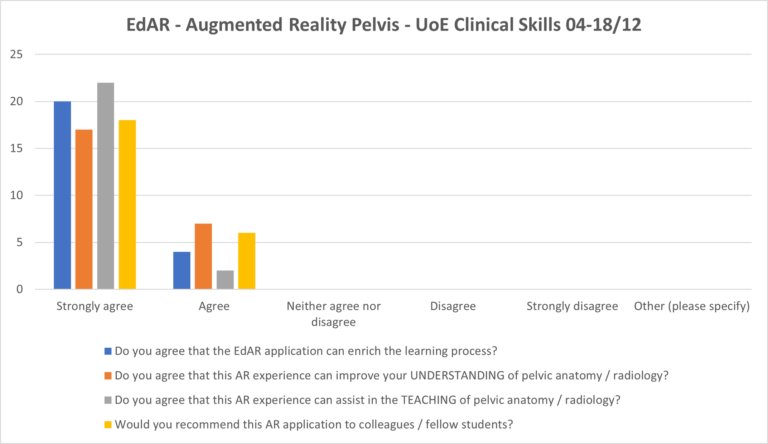In order to address these issues, we applied successfully for a Principal’s Teaching Award Scheme (PTAS) in 2019. This project aimed to address the ‘adoption gap’ by looking to identify and develop three pilot educational AR applications to promote digital technology in teaching.
By the end of the project, we achieved the following objectives:
- Developed and evaluated three pilot apps,
- Supported AR app production by student-led teams such as Formula Student.
- Surveyed the University’s current stock of AR/MR hardware available for teaching.
- Determined in which subject areas AR/MR offers most benefits [1].
The PTAS project demonstrated real interest around the use of AR for educational activities, and led to a successful proposal funded by EIT Digital, with a consortium of partners from across Europe: Babcock, Theorem Solutions, DTx Colab and the University of Minho.
Out of the EIT Digital project, a spin out company, EdAR Ltd, was formed with the aim of bridging the gap between educators and the capabilities of augmented reality in a sustainable and cost-effective way. The model is to partner with subject matter experts to develop engaging AR experiences for broadly applicable subjects. These experiences are then sold to the educational market, with royalties being passed back to the partner, creating a cost-effective way to bring engaging AR experiences into the curriculum.
AR experience examples
As EdAR, we developed numerous AR experiences, two of which were included in the Learning & Teaching Conference 2021 workshop “Augmented reality, STEM and remote learning”. The two experiences are the ‘Pelvis Experience’ and the ‘Ecology Experience’.
The ‘Pelvis Experience’ is an AR-enhanced learning experience developed in collaboration with The University of Edinburgh Medical School. The aim of this experience is to help teach students the orientation and position of CT scan images for complex parts of human anatomy such as the pelvis [2].
The physical 3D model of the pelvis can be examined and, with the help of AR, the user can control the axial, coronal and sagittal planes that are used to transect the body, to see the corresponding scan images.
There are two sizes for the pelvis’s physical models, a large one and a mini one that can be used by the student. There is also a version without the physical model where the pelvis is displayed on a screen.

Figure 1 – Pelvis Experience prototype

Figure 2 – Ecology Experience screenshot.
What have been the benefits to student learning?
The distinctive technological characteristics of mobile learning deliver positive pedagogical affordances. Previous results with mobile serious games support this [3]. Klopfer and Squire [4] mention that the most frequently reported characteristics of mobile learning are “portability, social interactivity, context, and individuality”, with portability as the most distinctive feature that automatically sets apart mobile learning from other learning methods [4] [5]. These positive pedagogical characteristics are further enhanced by the use of AR which gives the learners flexibility and makes complex spatial concepts more understandable.
In an effort to collect insights regarding the use of AR for educational activities, we ran a workshop. The cohort consisted of 19 undergraduate medical students, three Postgraduate trainees and two junior trainers (non – consultant) who demoed the Pelvis Experience using our 3D printed models.

Figure 3 – Undergraduate University of Edinburgh medical students, Postgraduate trainees and Junior trainers trying out the Pelvis Experience
The participants were asked if they used AR in the past. The majority of participants (16) never used AR in the past while 8 had.
In the question, “Do you agree that the EdAR application can enrich the learning process?”, 20 (83.33%) of the participants answered that they strongly agree with the statement, and four (16.67%) answered that they agree with the statement.

Figure 4 – Questionnaire answers.

